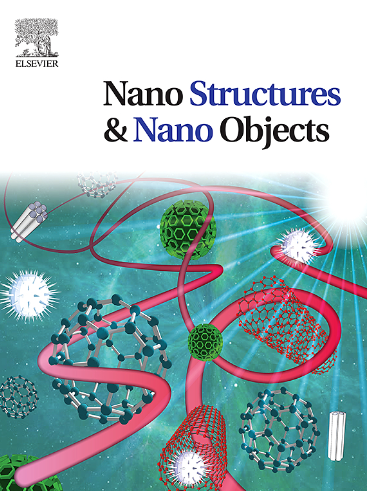Synergistic ultrasound and microwave synthesis of WO3 nanostructures for dielectric and supercapacitor performance
IF 5.45
Q1 Physics and Astronomy
引用次数: 0
Abstract
Microwave and ultrasound irradiation are two non-conventional types of energy that have been used to advance the field of inorganic nanomaterial synthesis, as these sources enable the production of enhanced synthetic efficacies, as well as environmental friendliness. In this study, we describe how we created WO₃ nanostructures using a new method that combines ultrasound and microwave energy for use in supercapacitors and dielectric devices. X-ray diffraction also confirmed a highly crystalline orthorhombic WO₃ structure. In contrast, SEM and FESEM microscopy revealed nanorod and nanosheet morphologies that formed amalgamated structures with an average crystalline size of 19–24 nm. The purity and composition of the synthesised material were confirmed by EDAX. Electrochemical measurements showed that the sample prepared with 5 min of ultrasonic irradiation had the highest specific capacitance of 252 F/g, with exceptional capacitance maintenance of 100 % after 3000 charge-discharge cycles, much greater than values that were previously reported for WO₃ synthesised by conventional hydrothermal or microwave-only processes (generally 44–200 F/g and lower retention). Dielectric results provided a dielectric constant of 6.88–14.16 at 1 kHz (40–100 °C) and an increase in AC conductivity with increasing frequency and temperature. Synergistic combinations of ultrasound and microwave irradiation yielded better crystallinity, agglomeration synthesis methods. This paper shows that using ultrasound with microwave-assisted WO₃ nanostructures can lead to better uses in future energy storage and dielectric-related applications.
超声和微波协同合成WO3纳米结构对介电性能和超级电容器性能的影响
微波和超声波辐照是两种非传统的能量,已被用于推进无机纳米材料合成领域,因为这些来源能够提高合成效率,同时对环境友好。在这项研究中,我们描述了我们如何使用一种结合超声波和微波能量的新方法来制造WO₃纳米结构,用于超级电容器和介电器件。x射线衍射也证实了一种高结晶的正交型WO₃结构。相比之下,SEM和FESEM显微镜显示纳米棒和纳米片形态形成了平均晶粒尺寸为19-24 nm的合并结构。合成材料的纯度和组成经EDAX确证。电化学测量表明,用5 min的超声辐照制备的样品具有最高的252 F/g的比电容,在3000次充放电循环后,其电容维持率为100% %,远高于以前报道的用常规水热或微波合成的WO₃的值(通常为44-200 F/g,保留率较低)。介电结果表明,在1 kHz(40-100°C)时介电常数为6.88-14.16,交流电导率随频率和温度的增加而增加。超声与微波协同作用,获得了结晶度、团聚性较好的合成方法。这篇论文表明,将超声波与微波辅助的WO₃纳米结构结合起来,可以在未来的能量存储和电介质相关应用中得到更好的应用。
本文章由计算机程序翻译,如有差异,请以英文原文为准。
求助全文
约1分钟内获得全文
求助全文
来源期刊

Nano-Structures & Nano-Objects
Physics and Astronomy-Condensed Matter Physics
CiteScore
9.20
自引率
0.00%
发文量
60
审稿时长
22 days
期刊介绍:
Nano-Structures & Nano-Objects is a new journal devoted to all aspects of the synthesis and the properties of this new flourishing domain. The journal is devoted to novel architectures at the nano-level with an emphasis on new synthesis and characterization methods. The journal is focused on the objects rather than on their applications. However, the research for new applications of original nano-structures & nano-objects in various fields such as nano-electronics, energy conversion, catalysis, drug delivery and nano-medicine is also welcome. The scope of Nano-Structures & Nano-Objects involves: -Metal and alloy nanoparticles with complex nanostructures such as shape control, core-shell and dumbells -Oxide nanoparticles and nanostructures, with complex oxide/metal, oxide/surface and oxide /organic interfaces -Inorganic semi-conducting nanoparticles (quantum dots) with an emphasis on new phases, structures, shapes and complexity -Nanostructures involving molecular inorganic species such as nanoparticles of coordination compounds, molecular magnets, spin transition nanoparticles etc. or organic nano-objects, in particular for molecular electronics -Nanostructured materials such as nano-MOFs and nano-zeolites -Hetero-junctions between molecules and nano-objects, between different nano-objects & nanostructures or between nano-objects & nanostructures and surfaces -Methods of characterization specific of the nano size or adapted for the nano size such as X-ray and neutron scattering, light scattering, NMR, Raman, Plasmonics, near field microscopies, various TEM and SEM techniques, magnetic studies, etc .
 求助内容:
求助内容: 应助结果提醒方式:
应助结果提醒方式:


